Australian View
The imagined audience for energyrealist is located on or within a few hundred miles of the north-east US corridor running from Boston to Washington, but we hope our message appeals to many others as well.
As we say on the home page we look to learning something from the experience – good and bad – of Australia and Germany, who have each embraced alternative energy with a lot of intensity.
The following content shows the Australian perspective. The contributions are by Warwick Rowell, unless otherwise indicated. Australia changed to decimal currency (the Australian dollar) from pounds, shillings and pence in 1966, and moved to the metric system from 1970 to 1988. All values are therefore in metric and $AUS, again unless specifically indicated otherwise. Dates are in Australian/European format i.e. Day/Month/Year, and spelling is in English English – which we hope does not offend or confuse our US readers.
The article “Permaculture and Climate Change in Western Australia” first appeared in Environment WA in 1991. It is still very relevant today, and certainly relevant to more than Western Australia.
“The first fifty percent is easy!“, addressing how households can cut their energy consumption, and their carbon emissions in half – while saving money – first appeared in 2007.
A worrying view, saying that we have gone too far already is expressed in this paper by David Hamilton presented in October 2009. David Hamilton is Charles Sturt Professor of Public Ethics, Centre for Applied Philosophy and Public Ethics at the Australian National University (clive.hamilton@cardou7.dreamhosters.comanu.edu.au) and currently standing for election to the Australian government as a member of the green party.
Warwick also writes a short note on how energy costs are distorted by government subsidies. This issue is not confined to Australia – in the US government subsidies distort the transportation system and all phases of the energy system. The realist will not try and untangle all of these issues, but in fairness point out that subsidies for energy audits and solar panels are as much a distortion of the system as are subsidies to nuclear power companies. At the homeowner level the main measure of energy cost is still how many cents per KWh (in whatever form: electricity, gas, oil…). Here are Warwick’s comments: “A quick comment on decision making concerning alternative sources of power. The dollar cost of your KWh is probably not the real cost. Like using diesel or gasoline, there are hidden subsidies that we have grown too used to. In 1993, a retiring engineer was commissioned to look across the state and discover the real costs of producing power for rural Western Australia. No environmental stuff, just what dollars went out the door. The average cost in 1993 was 91 cents per KWh. So there was then a hidden subsidy of 79c per KwHr; ie it is coming out of my taxes etc from somewhere else. What might that figure be today? If we say conservatively, a subsidy of $1.80 over the base rate, which was until very recently, still 12 c per KWh, then my consumption of just 6 KWhs per day gives a daily real cost of say $6, so an annual cost of say $2000 – for someone who is doing a lot to reduce their power consumption. We plan on spending around $40,000 on our next system, which will have wind and solar. In due course, this will feed back to the grid. This is the most economical form of long term energy storage. We will be paid for surplus generated in summer, and can “cash some of that in” in the winter, if there is a long cloudy spell.”
In November 2009 the realist traveled (Australian and English readers please excuse the spelling), and collected a few more pieces of information:
The pictures of the Albany wind farm show how such a project can be part of the landscape and become a tourist attraction.
The picture below shows the progress of Warwick’s new house. The notable points are:
- Very careful site selection and positioning of the house to integrate the need for heating, summer cooling, off-grid independence, the great views and integration with the land
- A solid concrete slab, thicker than normal as a thermal mass, with no penetrations.
- A massive stone wall, again as a thermal mass, which will form the main bedroom walls.
- Planned straw bale walls, massive karri (a west autralian eucalypt) beams.
- Large rain water tank – typical of Australian farm houses.
- Wind and solar PV for electricity, with the solar panels mounted on a ground frame, so that Warwick can tilt the panels manually for increased efficiency through the seasons.
- Dry composting toilet and grey water reuse.

Massive bedroom walls and rainwater tank
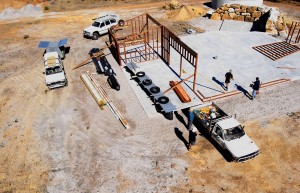
Update march 2010: The house in SW Australia is coming along. The framing is up, ready for the straw bales. A new wrinkle will be straw bales in the roof structure. Super insulation!

and here’s the roof with the straw bales in place:

The bales rest on metal roofing material (corrugated iron or “tin” in Oz usage) below and are about to be covered by metal roofing above.
Update July 2010:
5 more weeks until move-in. The bales are in the walls, so now it’s down to the usual fitting out of the house – drywall, plumbing, painting and so on.
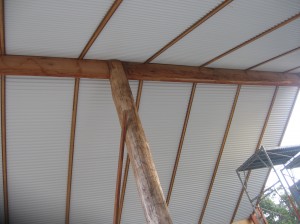
Interior, showing the underside of the roof. The insulating roof bales sit over the top. The central post is a karri log.

The house is almost complete (July 2010). This is a view into the bedroom with it's massive rock wall. The straw bale insulation is hidden behind the metal cladding.
Update March 2011:
Warwick and Gilli moved into their house a while ago and it looks like everything is going well. It will be interesting to see how the house performs once they accumulate a year’s worth of data. In addition to the solar hot water system, and the solar PV panels on the roof there will be a ground mounted solar array as well, with some experimentation on tilting the panels through the seasons. Warwick has also decided that he will tie to the grid (he has been off-grid for years), not so much for the continuing power, but to gain from the feed-in tarrifs being offered in Western Australia.
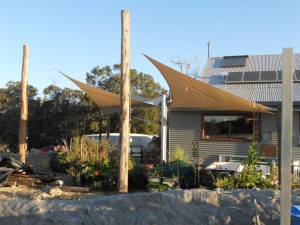
North side of the house, water tank in background, solar hot water and solar PV on roof (southern hemisphere = sun in the north!), shading "sails" in foreground

The inside is open and light. The floor is massive concrete for thermal mass. Straw bale insulation in the ceiling is visible through a demonstration panel on the lower left of the ceiling
Update – 1st October 2011:
Warwick has been in the house some time now. Looks like all is working as expected. He has decided to go on-grid with electricity, after being off-grid for many years. That way he benefits from the feed-in tariff available in Western Australia. The photos below are of part of the solar PV installation. A detailed discussion on the positioning and monitoring of the panels is here. Product specifications are here.
2 responses to “Australian View”
Leave a Reply
You must be logged in to post a comment.

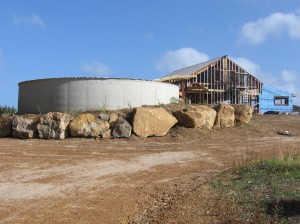



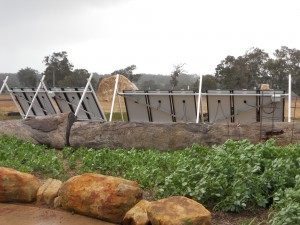
Nice house very well done. Low embodied energy and very efficient.
Most eco homes on the net are a joke. This is an exception
Good stuff Axel. Wish I had you build my last house. we heaps on insulation and 6kw solar and wind mill 2kw. We get a cheque each quarter from Engex 😉 Regs…Ian